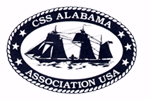
|

Dive Operations
 Latest News Latest News
 Detailed Information Detailed Information
Useful Links
 Naval Historical Naval Historical
Center
 W.S. Hoole W.S. Hoole
Special Collections
Library at the
University of
Alabama
|

|

|

|
Article 15
(July 7, 2002 - Cherbourg, France) American archaeologists working with
remote operated vehicle (ROV) operators
from the Naval Surface Warfare Center and Naval Historical Center aboard the
British research vessel Genesis have begun a survey to photographically
document the wreck site of the CSS Alabama. Although weather and equipment
problems plagued the first phase of the investigation, the unmanned
underwater vehicle was able to document exposed wreckage forward of the ship's
engineering space. One of the features documented by the ROV is the
galley stove which divers were unable to recover during two previous weeks of work
on the site in July. The galley stove and other artifacts from the crew's
quarters were slated for recovery to provide insight into what life was like
for the primarily British crew that served aboard Captain Raphael Semmes'
ship.
The galley stove and other artifacts from the crew's
quarters were slated for recovery to provide insight into what life was like
for the primarily British crew that served aboard Captain Raphael Semmes'
ship.
Captain Raphael Semmes' most famous ship lies approximately 7 miles off
Cherbourg Harbor on the Normandy coast. After a highly successful cruise of
almost two years, the CSS Alabama was sunk in an engagement with the USS
Kearsarge on 19 June 1864.  The international investigation of the CSS
Alabama is being sponsored by the Mobile Alabama based CSS Alabama
Association and the project has been funded by a Congressional appropriation
sponsored by Alabama Senators Jeff Sessions and Richard Shelby.
Their appropriation was channeled through the United States Navy Legacy Program.
Underwater Archaeological investigation of the CSS Alabama began in 1988,
four years after a French Navy mine hunting vessel discovered the wreck.
The international investigation of the CSS
Alabama is being sponsored by the Mobile Alabama based CSS Alabama
Association and the project has been funded by a Congressional appropriation
sponsored by Alabama Senators Jeff Sessions and Richard Shelby.
Their appropriation was channeled through the United States Navy Legacy Program.
Underwater Archaeological investigation of the CSS Alabama began in 1988,
four years after a French Navy mine hunting vessel discovered the wreck.
The American archaeological team made up of Gordon P. Watts, Jr., the
Principal Investigator and underwater archaeologist Mark Padover hope the
ROV will be able to collect sufficient photographs to construct a scaled
photomosaic of the wreck site.  That mosaic will provide the first image of
the entire wreck and provide an indication of how much of the ship survives.
Data from the survey will also be used to construct a computer based model
of the site. Watts and Padover are associated with the Institute for
International Maritime Research a Washington, North Carolina based not for
profit organization formed to conduct and sponsor maritime research and
underwater archaeology and are working on the CSS Alabama for the Mobile
Alabama based CSS Alabama Association headed by President Robert Edington.
That mosaic will provide the first image of
the entire wreck and provide an indication of how much of the ship survives.
Data from the survey will also be used to construct a computer based model
of the site. Watts and Padover are associated with the Institute for
International Maritime Research a Washington, North Carolina based not for
profit organization formed to conduct and sponsor maritime research and
underwater archaeology and are working on the CSS Alabama for the Mobile
Alabama based CSS Alabama Association headed by President Robert Edington.
|
|

|



